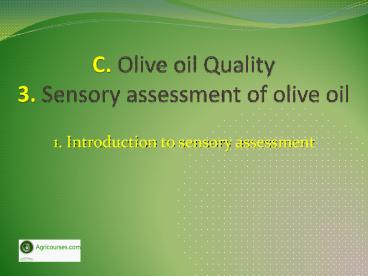Lecture 1: Introduction of sensory assessment - PowerPoint PPT Presentation
Title:
Lecture 1: Introduction of sensory assessment
Description:
This course focus on olive oil composition and quality, olive oil categories and types, positive and negative attributes of olive oil, labeling standards of olive oil and quality assurance of olive oil. – PowerPoint PPT presentation
Number of Views:53
Slides: 11
Provided by:
Username withheld or not provided
Category:
How To, Education & Training
Tags:
Title: Lecture 1: Introduction of sensory assessment
1
C. Olive oil Quality3. Sensory assessment of
olive oil
- 1. Introduction to sensory assessment
2
Sensory assessment of olive oil
- It is the detection and description of
qualitative and quantitative olfactory-gustatory
characteristics of virgin olive oil using human
senses and the classification of olive oil
according to its organoleptic characteristics
3
The purpose of sensory assessment
- The determination of the evaluation process of
the organoleptic characteristics of virgin olive
oil - The adoption of this classification method based
on the characteristics of the method
4
IOC and sensory assessmentof olive oil (part I)
- The International Olive Oil Council (IOOC) has
developed a system for the objective organoleptic
(tasting) assessment of olive oil in order to
determine an oils quality and commercial trade
value
5
IOC and sensory assessmentof olive oil (part II)
- This assessment method is based on panels of
trained tasters recognizing the absence and/or
presence of specific positive and negative
(defective) attributes
6
Application of sensory assessment
- A group of 8 to 12 tasters is selected, trained
and controlled - It can be applied only to the classification of
virgin olive oil, according to the perceived
intensity of the predominant defect and the
presence or not of fruitiness
7
Determination of sensory assessment
- Chemical laboratories in 9 countries (1982-1985)
- Continuous improvement of the process with new
additions - A recent modification of the method the
determination of the mounting tension of the
sample in relation to the distance between the
glass and the nose
8
Sensory tests (part I)
- Sensory difference tests are procedures used to
determine whether judges can distinguish between
two similar stimuli - In terms of olive oil, the two stimuli are two
very similar olive oil samples
9
Sensory tests (part II)
- Difference tests are particularly well adapted to
the assessment of vegetable oils during their
processing, being used to control refining
efficiency
10
Summary of 1st Lecture
- Purpose of sensory assessment
- Application of sensory assessment
- Sensory tests































